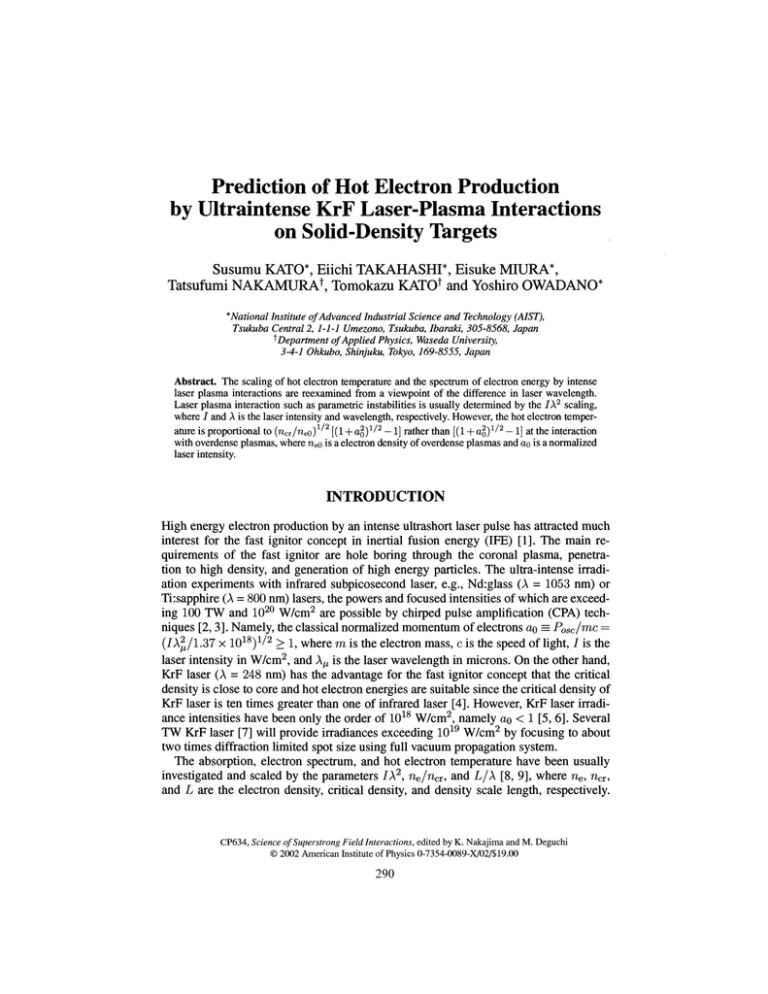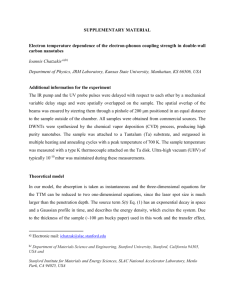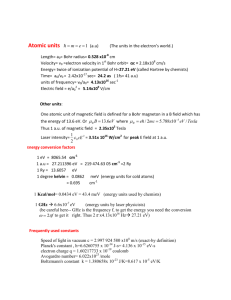Prediction of Hot Electron Production by Ultraintense KrF Laser-Plasma Interactions
advertisement

Prediction of Hot Electron Production by Ultraintense KrF Laser-Plasma Interactions on Solid-Density Targets Susumu KATO*, Eiichi TAKAHASHF, Eisuke MIURA*, Tatsufumi NAKAMURA*, Tomokazu KATOf and Yoshiro OWADANO* * National Institute of Advanced Industrial Science and Technology (AIST), Tsukuba Central 2, 1-1-1 Umezono, Tsukuba, Ibaraki, 305-8568, Japan ^Department of Applied Physics, Waseda University, 3-4-1 Ohkubo, Shinjuku, Tokyo, 169-8555, Japan Abstract The scaling of hot electron temperature and the spectrum of electron energy by intense laser plasma interactions are reexamined from a viewpoint of the difference in laser wavelength. Laser plasma interaction such as parametric instabilities is usually determined by the IX2 scaling, where / and A is the laser intensity and wavelength, respectively. However, the hot electron temperature is proportional to (ncr/neo)1^ [(14-ao)1/2 -1] rather than [(1 + «o)1/2 -1] at the interaction with overdense plasmas, where neo is a electron density of overdense plasmas and ao is a normalized laser intensity. INTRODUCTION High energy electron production by an intense ultrashort laser pulse has attracted much interest for the fast ignitor concept in inertial fusion energy (IFE) [1]. The main requirements of the fast ignitor are hole boring through the coronal plasma, penetration to high density, and generation of high energy particles. The ultra-intense irradiation experiments with infrared subpicosecond laser, e.g., Nd:glass (A = 1053 nm) or Tirsapphire (A = 800 nm) lasers, the powers and focused intensities of which are exceeding 100 TW and 1020 W/cm2 are possible by chirped pulse amplification (CPA) techniques [2,3]. Namely, the classical normalized momentum of electrons ao = Posc/rac = (/A 2 /1.37 x 1018)1/2 > i, where m is the electron mass, c is the speed of light, / is the laser intensity in W/cm2, and AM is the laser wavelength in microns. On the other hand, KrF laser (A = 248 nm) has the advantage for the fast ignitor concept that the critical density is close to core and hot electron energies are suitable since the critical density of KrF laser is ten times greater than one of infrared laser [4]. However, KrF laser irradiance intensities have been only the order of 1018 W/cm2, namely ao < 1 [5, 6]. Several TW KrF laser [7] will provide irradiances exceeding 1019 W/cm2 by focusing to about two times diffraction limited spot size using full vacuum propagation system. The absorption, electron spectrum, and hot electron temperature have been usually investigated and scaled by the parameters /A2, ne/ncr, and L/A [8, 9], where ne, ncr, and L are the electron density, critical density, and density scale length, respectively. CP634, Science of Super strong Field Inter actions, edited by K. Nakajima and M. Deguchi © 2002 American Institute of Physics 0-7354-0089-X/02/$ 19.00 290 Critical density absorption of the laser light converts laser energy into hot electrons with a suprathermal temperature Th0t approximately proportional to \//A2 for ao > 1, and Thot ~ [(1 + ao)1//2 - l]rac2 at moderate density [10], where me2 = 511 keV is a electron rest mass, Thot = 160 keV, 0.92 MeV, and 3.88 MeV for 1X^ = 1 x 1018, 1 x 1019, and 1 x 1020 W/cm2//m2, respectively. The scaling of the hot electron temperature is supported by experiments of Ndrglass and Ti:sapphire lasers [11, 12]. On the other hand, the results from one dimensional simulation for normal incidence have shown that T^t ~ f?(^cr/'fteo)Q! [(1 + ao)1^2 — l]^c2 in the density region 10 < neQ/ncr < 100 and the normalized intensity 4 < 0% < 30, where 77 = 1.2 ~ 1.9 and a = 1/2, which weekly depend on /A 2 and ne/ncr [9], When ao > 1, Th0t oc ^(//neo) 1 , namely the hot electron temperature is almost independent of the wavelength. In this paper, the scaling of the hot electron temperature and the electron energy spectrum are reexamined from a viewpoint of the difference in laser wavelength using a particle-in-cell (PIC) simulation code. The difference in hot electron spectrum and flux between KrF laser and Infrared laser is clarified. The results predict the spectrum of the high energy particle generated in a KrF laser experiment at exceeding 1019 W/cm2 irradiance. PIC SIMULATION To investigate hot electron generation for oblique incidence, we use the relativistic 1 and | dimensional PIC simulation with the boost frame moving with csin# parallel to the target surface, where 0 is an angle of incidence [13, 14]. In the simulation, the targets are the full ionized plastic (CH) and aluminum, and the electron densities are neo ~ 3.5 x 1023cm~3 and 8.6 x 1023cm~3, respectively. The densities correspond to = 20 and 48 for A = 0.25 //in, neo/ncr = 78 and 190 for A = 0.5 /xm, and cr = 310 and 770 for A = 1/xm, respectively, where ncr is the critical density. The density profile has a shape density gradient, ne(x) = neo for x > 0 and ne(x) = 0 for x < 0. The laser intensity rises in 5 fs and remains constant after that. The irradiated intensity / = 5 x 1019 W/cm2 and the angle of incidence 9 = 30° (p-polarized). 0% = 2.3, 9.2, and 36 for A = 0.25/un, A = 0.5/on, and A = I/an, respectively. The momentum and energy of electrons, the electromagnetic fields, and the electron and ion densities are measured after 50 fs. Figures 1 show snapshots of the electron phase space for neo = 3.5 x 1023cm~3. Figures l(a-c) and l(d-f) show for A = 0.25 //m and 1 /^m, respectively. The profiles of the electromagnetic fields and the electron and ion densities at t = 50 fs are shown in Fig.2. The results show that the electron and ion density profiles of A = 0.25 /^m are quite different from the profiles of A = 1 /im. The gradient on the surface of the solid density plasma is still steep for A = 1 //m. However, the gradient for A = 0.25 //m is gentle compared with one for A = 1 //m. In the case of A = 0.25 /xm, the electric fields penetrate into dense plasma because of the gentle density gradient. Normalized electron energy distributions are shown for the plastic (neo — 3.5 x 1023cm~3) and aluminum (neo = 8.6 x 1023cm~3) in Fig.3(a) and 3(b), respectively. The hot electron temperatures of the plastic (ne0 - 3.5 x 1023cm~3) are 190 keV, 120 keV, and 60 keV, for 0.25 291 §§ Normalized momentum Py o ro o £» o Normalized momentum Px Normalized momentum Py o> o en v-» - .:--•:,.,,.........• 0 ":"'>-'-".'-'.. ;..-; ;-. •- (D 10 a o ~ '-::..:•':•- - - - 7 « O & 0 •'.K^- . . . 3 X -* 'Tj f . ' 31 * £ H *"* bi 3 S 7 2 ®£ i ' • i Normalized momentum Py Normalized momentum Py to Normalized momentum Px o o -0 01 6" 8 & 30 -0.05 0 0.05 0.1 Distance (jim) FIGURE 2. Profiles of the electromagnetic fields and the electron and ion densities at t = 50 fs, neo — 3.5 x 1023cm~3. The solid and open symbols are for A = 0.25 //m and 1 //m, respectively. /mi, 0.5 /^m, and 1 //m, respectively. The hot electron temperatures of the aluminum (ne0 = 8.6 x 1023cm-3) are 170 keV, 80 keV, and 40 keV for 0.25 //m, 0.5 //m, and 1 /xm, respectively. Applying the simulation results of the hot electron temperature to TLot ~ V Kr/neo)1/2 [(1+«o)1/2 ~ !]mc2' V ~ 2.0 and 2.8 for A - 0.25/xra, 77 ~ 0.95 and 0.98 for A = 0.5//m and 77 ~ 0.41 and 0.43 for A = ljura, respectively. In one dimensional simulation for normal incidence [9], 77 weekly depend on both /A2 and ne/ncr. 77 oc A"1 in our simulations of p-polarized oblique incidence. It is noted that 77 strongly depends on the incident angle, polarization, and density scale length, and also depends on ncr/ne in our simulations. SUMMARY AND DISCUSSIONS The hot electron temperature is scaled by 7h0t ~ ^(^cr/^eo)1^2 [(1 + ^o)1//2 ~ I]™?2 rather than Th0t ~ [(1 + &o)^2 ~ l]^c2 at the interaction with overdense plasmas. In the condition of our simulations, 77 ex A"1. The difference between our results and Wilks's results may be attributed to the polarization of the laser light. For various laser and plasma conditions, the more quantitative details of the energy and angular spectrum of 293 0.2 0.4 0.6 mc 2 (y-1) 0.8 0.2 0.4 0.6 mc 2 (y-1) 0.8 FIGURE 3. Electron energy distribution at t = 50 fs and I = 5 x 1019 W/cm2 for (a) n^ = 3.5 x 1023cm~3 and (b) neo = 8.6 x 1023cm~3, respectively. The solid, dashed-doted, and dotted lines are for A = 0.25 /um, 0.5 /xm, and 1 //m, respectively. The hot electron temperatures are (a) 190, 120, and 60 keV and (b) 170, 80, and 40 keV for 0.25 //m, 0.5 ^m, and 1 //m, respectively. the fast particle and the multi-dimensional effects such as surface deformation [10] will be investigated further in the future. Finally, we discuss the effect of preformed plasma by a prepulse of the intense short pulse laser that is an essential problem in an actual long wavelength experiment [15,16]. We are afraid of both the absorption of the short pulse in the preformed plasma and the distance between the ablation surface and critical surface. That prevent the interaction between intense KrF laser pulse and solid density plasma. Here, we estimate a preformed plasma profile and volume by the prepulse, the intensity and pulse width of which are assumed to be 1012 W/cm2 and 2 ns, respectively. Here, we estimate a preformed plasma profile and volume by the prepulse, assuming the intensity and pulse width are 1012 W/cm2 and 2 ns, respectively. Total particle number and scale length by the ablation will be 2 x 1020 cm~2 and 40 /^m. The plasma temperature will be greater than 3 keV, when the intense short pulse energy density > 2J/7r(10/zm)2 in the preformed plasma and 5% of its energy is absorbed. The absorption in the preformed plasma is negligible, because the effective absorption length with 3 keV is about 50 jum. Intense laser pulse interacts with solid density plasmas, since the stand off distance is proportional to A14/4 [17] and short enough compared with wavelength by KrF laser. Therefore, KrF laser is suitable for the interaction with solid density plasmas even if the prepulses exist. ACKNOWLEDGMENTS A part of this study was financially supported by the Budget for Nuclear Research of the Ministry of Education, Culture, Sports, Science and Technology, based on the screening and counseling by the Atomic Energy Commission. 294 REFERENCES 1. 2. 3. 4. 5. 6. 7. 8. 9. 10. 11. 12. 13. 14. 15. 16. 17. Tabak, M., Hammer, J., Glinsky, M. E., Kruer, W. L., Wilks, S. C., Woodworth, J., Campbell, E. M., and Perry, M. D., Phys. Plasmas, 1, 1629-1634 (1994). Maine, P., Stricland, D., Bado, P., Pessot, M., and Mourou, G., IEEE J. Quantum Electron., 24, 398-403 (1988). Perry, M. D., Pennington, D., Stuart, B. C., Tietbohl, G., Britten, J. A., Brown, C., Herman, S., Golick, B., Kartz, M., Miller, J., Powell, H. T., Vergino, M., and Yanovsky, V., Opt. Lett., 24, 160160 (1999). Shaw, M. J., Ross, I. N., Hooker, C. J., Dodson, J. M., Hirst, G. J., Lister, J. M. D., Divall, E. J., Kidd, A. K., Hancock, S., Damerell, A. R., and Wyborn, B. E., Fus. Eng. Design, 44, 209-214 (1999). Teubner, U., Uschmann, I., Gibbon, P., Altenbernd, D., Forster, E., Feurer, T., Theobald, W., Sauerbrey, R., Hirst, G., Key, M. H., Lister, J., and Neely, D., Phys. Rev. E, 54, 4167-4177 (1996). Borghesi, M., Mackinnon, A. J., Gaillard, R., Willi, O., and Riley, D., Phys. Rev. E, 60, 7374-7381 (1999). Owadano, Y, "Development of a high-repetition-rate electron-beam-pumped KrF laser," in Second International Conference on Inertial Fusion Sciences and Applications, 2001, Kyoto, Japan, 2002. Lefebvre, E., and Bonnaud, G., Phys. Rev. E, 55, 1011-1014 (1997). Wilks, S. C., and Kruer, W. L., IEEE J. Quantum Electron., 33, 1954-1968 (1997). Wilks, S. C., Kruer, W. L., Tabak, M., and Langdon, A. B., Phys. Rev. Lett., 69,1383-1386 (1992). Malka, G., and Miquel, J. L., Phys. Rev. Lett., 77,75-78 (1996). Oishi, Y, Nayuki, T., Nemoto, K., Okano, Y, Hironaka, Y, Nakamura, K. G., and Kondo, K., Appl. Phys. Lett., 79, 123^1236 (2001). Bourdier, A., Phys. Fluids, 26,1804-1807 (1983). Gibbon, P., and Bell, A. R., Phys. Rev. Lett, 68, 1535-1538 (1992). Yu, W, Bychenkov, V., Sentoku, Y, Yu, M. Y, Sheng, Z. M., and Mima, K., Phys. Rev. Lett., 85, 570-573 (2000). Cowan, T. E., Hunt, A. W, Phillips, T. W., Wilks, S. C., Perry, M. D., Brown, C., Fountain, W, Hatchett, S., Johnson, J., Key, M. H., Parnell, T., Pennington, D. M., Snavely, R. A., and Takahashi, Y, Phys. Rev. Lett., 84, 903-906 (2000). Manheimer, W. M., Colombant, D. G., and Gardner, J. H., Phys. Fluids, 25, 1644-1652 (1982). 295



